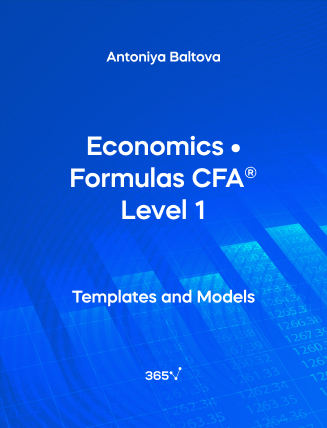Need an all-in-one list with the Economics formulas included in the CFA® Level 1 Exam? We have compiled them for you here. The relevant formulas have been organized and presented by chapter. In this section, we will cover the following topics — Demand and Supply Analysis, Firm and Market Structures, Aggregate Output, Prices, and Economic Growth, Business Cycles, Monetary and Fiscal Policy, International Trade, Capital Flows, and Currency Exchange Rates.
1. Topics in Demand and Supply Analysis
Price Elasticity
Price~elasticity = \frac {\%Δ~Quantity~demanded~(Qx)}{\%Δ~Price~(Px)}0 > e > -1 rightarrow inelastic demand
-1 > e > -∞ rightarrow elastic demand
e = -1 rightarrow unit elastic demand
e = 0 rightarrow perfectly inelastic demand
e = -∞ rightarrow perfectly elastic demand
Income Elasticity
Income~elasticity = \frac {\%Δ~Quantity~demanded~(Qx)}{\%Δ~Income~(Ix)}e > 0 rightarrow normal goods
e < 0 rightarrow inferior goods
ε{_Y} = Income elasticity
Cross-price Elasticity
Cross-price~elasticity = \frac {\%Δ~Quantity~demanded~(Qx)}{\%Δ~Price~of~a~related~good~(Py)}e > 0 rightarrow the related product is a substitute
e < 0 rightarrow the related product is a complement
y = Related product
ε{_{py}} = Cross-price elasticity
2. The Firm and Market Structures
For all market structures, Max Profit \longrightarrow when MC = MR
MC = Marginal cost
MR = Marginal revenue
Breakeven points:
AR = ATC (perfect competition)
TR = TC (imperfect competition)
ATC = Average Total Cost
AR = Average Revenue
TR = Total Revenue
TC = Total Cost
AR = ATC holds true in imperfect competition
Short-run shutdown points:
AR < AVC (perfect competition)
TR < TVC (imperfect competition)
Market structures:
Perfect Competition
Monopolistic Competition
Oligopoly
Monopoly
3. Aggregate Output, Prices, and Economic Growth
Total GDP = Final value of goods and services produced (market value)
+ Government services (at cost)
+ Rental value of owner-occupied housing (an estimate)
GDP~Deflator = \frac{Nominal~GDP}{Real~GDP} \times 100Nominal~GDP{_t} = P{_t} \times Q{_t}Real~GDP{_t} = P{_{b}} \times Q{_t}t = Current year
b = Base year
P{_t} = Prices in year {_t}
P{_b} = Prices in base year
Q{_t} = Quantity produced in year {_t}
Expenditure Approach
Real~GDP = Consumption~spending~(C) + Investment~(I) + Government~spending~(G) + Net~exports~(X-M)
X = Exports
M = Imports
Income Approach
Real~GDP = National~income + Capital~consumption~allowance + Statistical~discrepancy
Real~GDP = Consumption~spending~(C) + Savings~(S) + Taxes~(T)
Savings~(S) = Investments~(I) + Fiscal~Balance~(G-T) + Trade~Balance~(X-M)
S – I = Fiscal~Balance~(G-T) + Trade~Balance~(X-M)
National Income = Employees’ compensation
+ Corporate and government profits before taxes
+ Interest income
+ Unincorporated business net income (business owners’ incomes)
+ Rent
+ Indirect business taxes
− Subsidies
Personal Income = National income
+ Transfer payments (social insurance, unemployment or disability payments)
− Indirect business taxes
− Corporate income taxes
− Undistributed corporate profits
Personal Disposable Income = Personal income – Personal taxes
Potential GDP = Aggregate hours worked × Labor productivity
\longrightarrow Aggregate hours worked = Labor force × Average hours worked per week
\longrightarrow Growth in Potential GDP = Growth in labor force + Growth in labor productivity
The Production Function
Y = A \times f (K, L)
Y = Aggregate output
A = Total Factor Productivity (TFP)
K = Capital
L = Labor
Growth in Potential GDP = Growth in technology + WL × (growth in labor) + WC × (growth in capital)
WL = Labor’s percentage share of national income
WC = Capital’s percentage share of national income
3. Understanding Business Cycles
Unemployment~Rate = \frac {Number~of~unemployed~people}{Total~labor~force}Participation~Rate~(Activity~Ratio) = \frac {Total~labor~force}{Total~working–age~population}Labor~Force = Unemployed~people + Employed~people
Unemployed = Looking for job
Consumer~Price~Index = \frac {Cost~of~basket~at~current–year~prices}{Cost~of~basket~at~base–year~prices} \times 100Laspeyres’ Index = \frac {\Sigma~(Current–year~price \times Base–year~quantity)}{\Sigma~(Base–year~price \times Base–year~quantity)}Fisher’s~Index = \sqrt {(Laspeyres’~Index) \times (Paashe~Price~Index)}Paashe~Price~Index = \frac {\Sigma~(Current–year~price \times Current–year~quantity)}{\Sigma~(Base–year~price \times Base–year~quantity)}4. Monetary and Fiscal Policy
Money~Multiplier = \frac {1}{Reserve~requirement}Fiscal~Multiplier = \frac {1}{1- MPC \times (1- t)}MPC = Marginal propensity to consume
t = Tax rate
Equation of Exchange
MV = PY~(Money~supply \times Velocity = Price \times Real~output)
Fisher Effect
Nominal~Interest~Rate = Real~interest~rate + Expected~inflation~rate
Neutral Interest Rate
Neutral~interest~rate = Real~trend~rate~of~economic~growth + Inflation~target
5. International Trade and Capital Flows
GDP
GDP = C + I + G + X - M
C = Consumption
I = Investments
G = Government Spending
X = Export
M = Import
Balance of Payments
Current~Account + Capital~Account + Financial~ Account = 0
Trade Balance
X - M = Private~Savings + Government~Savings - Investments~in~domestic~capital
6. Currency Exchange Rates
Real~Exchange~Rate = Nominal~exchange~rate \times \frac {CPI~base~currency}{CPI~price~currency}Follow the links to find more formulas on Quantitative Methods, Corporate Finance, Alternative Investments, Financial Reporting and Analysis, Portfolio Management, Equity Investments, Fixed-Income Investments, and Derivatives, included in the CFA® Level 1 Exam.

